

B. J. Ram Rao
Manager (Software Projects), Information Systems Division
On my first trip to Japan, I arrived in Tokyo on Sunday, 26th May 1996 by Air-India AI-308 which departed Bombay at 6:40 pm on Saturday. Took the airport shuttlebus to the Hotel Shinagawa Prince. The fare was ¥ 2,900.
Japan is an archipelago, a chain of four main islands and about 4000 lesser islands that extends for about 4800 kilometers north to south totaling a land mass of 377,765 sq. km. The four main islands are Honshu (Mainland), Hokkaido, Kyushu and Shikoku. Among the best known of the lesser islands is Okinawa.
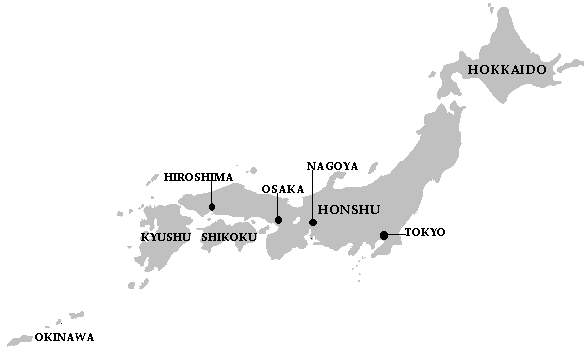
The Japanese Yen comes in 1000, 5000, and 10,000 bills. There are 500, 100, 50, 10, 5 and 1 yen coins.
Trains and the Subway
Trains and the subway require that you buy a ticket from an automatic machine. The farther you are traveling, the more the ticket costs. If you don't know how much the ticket should be, just buy the cheapest ticket you can. When you enter the station, there is usually a slot in the electronic entry gate where you must put your ticket in. The automatic ticket validator will process your ticket at lightning speed and spit it out from a different slot at the gate. You must recover your ticket before proceeding.
Depending on the station that you arrive at, you will find either a live ticket taker (I found rather friendly JR people at Shin-Yokohama which was my destination every morning) that you give the ticket to, or a slot in the exit gate (This was the case at Shinagawa, where I lived). When you put the ticket in the automatic slot, the gate will determine if the ticket is for the right amount. If it isn't, an alarm will buzz and the gate will close on you. You'll then have to go to a fare adjustment window where you'll be told how much to pay to make up the difference. Of course, don't ask, most stations have an electronic fare adjustment machine that can "read" your ticket, gobble it up, charge you a difference and give you a ticket to feed the electronic validator in the exit gate. क्या hi-tech था, भाई!!
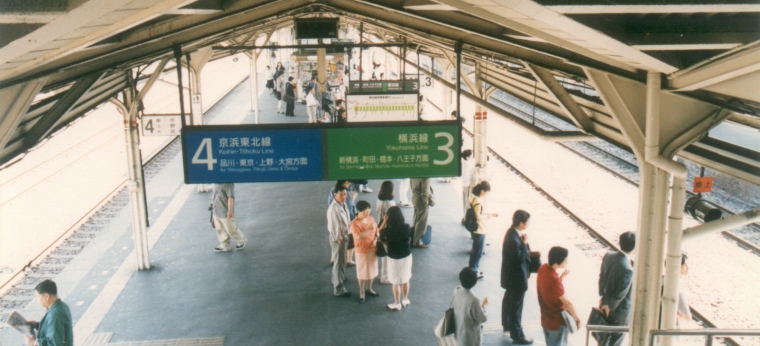 |
||
|
It is quite common outside railway stations and in shopping centers to see pretty young girls giving away small sachets of paper-tissues. I was told the colorful covers on the sachets contain advertisements aimed at the man on the street. I observed many Japanese pocketing these paper-tissue packs.
Many of the public toilets do not have toilet paper. And, many places do not have towels for drying your hands when you wash them, only electric hot-air dryers. It makes sense for a visitor to carry his own paper-tissues. Ah! Wakarimashita (समझ में आयी बात!)
Tokyo commuter train
10% of the Japanese population lives in the Tokyo area. The commuter train at rush-hour is extremely crowded. (I was informed that over two million people pass through the Shinjuku station on any given business day) Everyone hangs limply from gray plastic rings on leather straps with inert expressions suggesting deep meditation or light hypnosis. Impetus rolls through the tightly-packed bodies like currents through a thick patch of grass.
Lots of young Japanese read juvenile comics. and listen to "Walkman" type personal audio equipment. The Japanese commuter is rarely seen sleeping on the train. Many Japanese carry PDAs and use them in the train. Others read a small paper-back book.
A portable phone chirps on somebody's person and a bogieful of humanity, rummages through their pockets, briefcases and handbags to check if their instrument needs attention. The one that did, continues chirping as if in protest, against the bermuda clad, ponytailed, single-ear-ringed cool guy whose Sony Discman has drowned out his attention to his portable communicator.
Nobody is looking at anybody. Were any physical threat or commotion offered on this subway, the situation would swiftly be nightmarish. But since nobody stirs, the experience is actually oddly soothing.
Everything came across as very electronics-embedded, high-technology, high-quality and very expensive. There were LCD/ Flatpanel Active matrix/Passive Matrix Displays everywhere.
Miniaturization
(The kei-haku-tan-sho (lightweight-thin-short-small) trend)
The first pocket-sized transistor radio I saw was a Japanese Asibo, acquired by my father, the late Mr. B. R. Jagannatha Rao in 1966. Ever since I have been keenly interested witness to the spread of Japanese miniaturization. Japanese lifestyles and small homes are observed to support rapid market acceptance of the kei-haku-tan-sho concept.
This includes tiny TVs and stereos suited for typically small living spaces.
Most Japanese use trains and buses, unlike Americans who drive a car. The Sony "Walkman" and its brothers-in-spirit from other manufacturers have made it possible to listen to radio or tapes privately during the commute. Small-sized paperback books are easy for commuters to carry and read. The portions of take-away food are smaller with a declining average number of members per family. In clothing, down ski jackets have been reduced in thickness from 20 mm to 5 mm. In automobiles, Suzuki introduced its miniature "Suzuki Alto" car. Even Japan's miniature bonsai trees have gotten smaller with the introduction of "mini" bonsai trees.
Japanese lifestyles and small homes echo the miniaturization concept.
The miniature compo stereo and miniature TVs further this drive toward products for small living spaces. Japan's miniature bonsai trees keep with the same theme.
Another curious miniature (miniature curiosity?) is the Japanese Capsule Hotel!
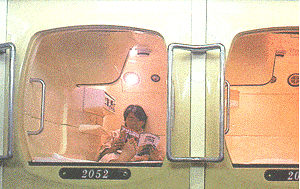
also known as Coffin Capsules. For 3500 to 5000 yen, you can rent a slot in the wall 3' x 3' x 6'. The slot will have a light, radio, TV, sheets and bedding, and a curtain over the entrance. The hotel will also have a public bath, TV room, vending machines, small locker for your street clothes, a sleeping robe, and maybe even a little restaurant.
Depositing your shoes at reception, you are shown inside to a room full of lockers. Into these go your clothes and personal belongings. Your clothes are swapped for a 'yukata' (a basic cotton bathrobe common in Japanese hotels) and a pair of slippers. You are then free to walk around the facility. The facility consists of rows upon rows of capsules, a big-screen tv, and vending-machines full of all sorts of stuff - most notably, 1-litre cardboard cartons of saki (Japanese rice wine). The capsules themselves, after you've fiddled with the radio, and watched the inbuilt tv (with your individual coin-slot for porn) are fairly uninteresting. The bedding consists of a foam matress, sheet and doona (quilt).
I thought this was a flashy air-conditioned equivalent of the pipe-dwellings in Mumbai. You know the folks that live in the RCC Hume pipes left here and there by the Brihanmumbai Municipal Corp., while they're busy preparing a PMP for installing the RCC pipes into the sewage system. These Coffin Capsules are made for businessmen who're low on money, and a need to sleep overnight in some town before moving on. Everything's made of off-white polished plasticky fiber-glass or stainless steel and feels like the interior of an aircraft toilet, complete with swiveling light and socket-swiveling a/c vents. The capsules are numbered like the bodydrawers in a mortuary. They are not good places for staying more than a few days, and there is no place to store belongings or purchases. But for short-term crash space, they're rather pleasant. So's a Maruti 800 or Omni!
The Japanese have large cars, "Nissan Cedric" and "Toyota Crown Royal Saloon" but have an acute premium on parking space. Close to where Abhijeet Barde lived I saw cars stacked three-high on a hydraulic car parking system. "क्या दब-दबके रहत हैं, भाई!!".

Close by, I saw a Japanese ground-floor condominium apartment, whose exterior wall was sculpted to accommodate more than the front half of a BMW, which was parked "into" the excavation.
On June 21, 1996, Nippon Telegraph and Telephone Corp. (NTT) released a prototype "wristphone" just bigger than a conventional telephone pager -- and it tells the time too. A speaker and a microphone are built into the phone body, with an antenna in the band. Voice-Recognition System: To make a phone call, a user just pushes a button on the body and speaks the phone number into the microphone. The phone's voice-recognition system converts the sound into numerical data.
The 70 g model, is the world's smallest cellular phone based on the Japan-developed PHS mobile communications system. It will be introduced in the market around 2000 at a retail price of about 50,000 yen (US $463)
Japanese Tea (Ocha).
The Japanese drink green tea. When they take a break, they say "let's take a tea break". Tea related words in the Japanese language besides "ocha (tea)", include "ochazuke (boiled rice in tea)", "ochauke (tea cake)", "cha-nomi tomodachi (bosom companion [tead-drinking friend])", "chanoma (living room)", etc. Tea is a big thing in Japan.
Wa-kei-sei-jyaku is
the key theme in the tea ceremony,
"Wa" is Harmony between ourselves and nature, between different
aspects of our surroundings, between nature's seasons and our man-made
environment and between us and other people.
"Kei" is Respect for, and the act of giving particular
attention to the moment, each person, time, ourselves, the objects we
use and nature. In showing this respect, we demonstrate our
understanding of the interconnectedness of all things. And having shown
respect, we understand even better why it is valued.
"Sei" means Purity of mind (like the
clear stream) of purpose and action (undiluted focus), of vision
(clarity of goal). To be pure is to contain nothing that does not
properly belong; so that we are not weighed down or distracted by that
which contributes nothing to the good of the whole.
"Jyak" means Tranquility. Tranquility the state of being free
from agitation of mind and spirit. If we are in harmony with our
environment and if we respect the moment and what it brings us, then we
can achieve purity of mind, purpose and action, and thus carry with us
a state of tranquility. Through the practice of Harmony Respect and
Purity, Tranquility is ours to choose, and to create within ourselves.
"Jyaku" represents "wabi" and "sabi" which is
the principle of beauty conscious serenity. "Wabi" stands for the
refinement found in rusticity and "sabi" for the beauty in age. This is
based on the Zen idea.
Food etiquette
Beer comes in large, 1-liter bottles and is meant to be shared with your companion(s). Typical Japanese brands of Beer are Kirin, Sapporo, and Asahi. It's bad manners to order a big bottle in a restaurant and keep it all to yourself. Also, never never pour your own beer. First, pour some for your friend(s), and place the bottle near them to fill your glass.
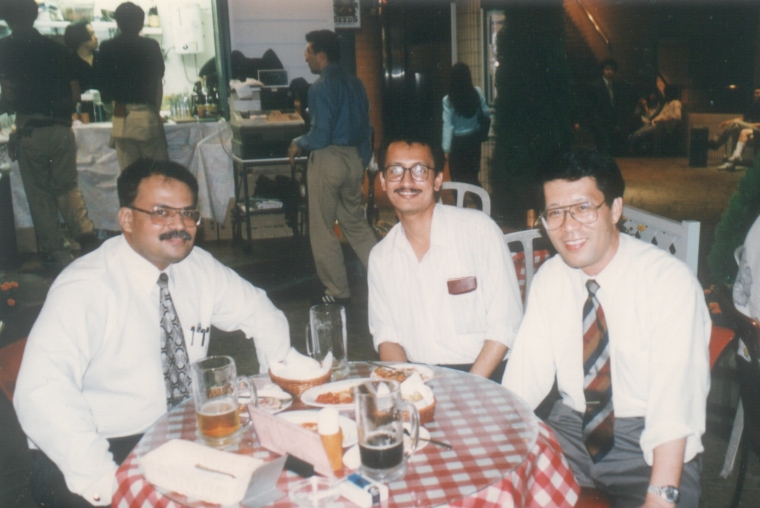
My client:Nozomi Tanabe, my engineer:Abhijeet Barde and myself.
While eating a soup or other liquid food, it's perfectly okay in Japan to bring the bowl to your mouth and slurp it directly. In fact, slurping out loud is even a sign of a healthy appetite and compliments to the chef!
After you finish your meal, you should say "gochisosama deshita" or just "gochisosama." Equivalent to saying in Marathi, "पोटोबा भरला" (Stomach is full to satisfaction!) This is to give thanks for a delicious meal. You can say it in general, to the host, and even to the restaurant workers as you walk out. But before you walk out, ensure all the little bowls are covered again.
Tipping is something, never done in Japan! It is way undignified for any waiter or taxi-driver to accept your tip for performing his/her salaried duty.
Shinagawa
The Shinagawa Prince Hotel located at 10-30 Takanawa 4-Chome, Minato-Ku, Tokyo is a 3008-room hotel, located at the south gate of Tokyo, in front of the Shinagawa station.
From the 39th floor, the hotel affords a magnificent view of the Tokyo Tower and the Rainbow Bridge, Tokyo.
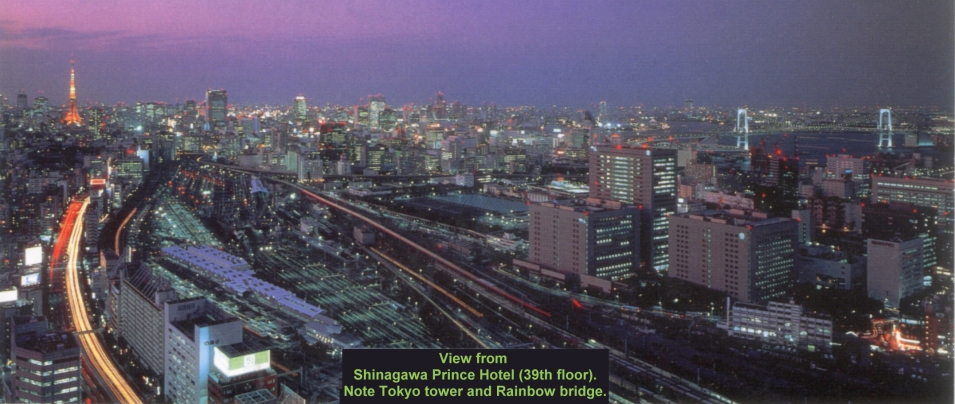
I stayed at a single-bed room at the Shinagawa Prince Hotel (Main tower).
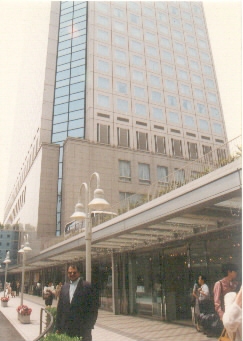 |
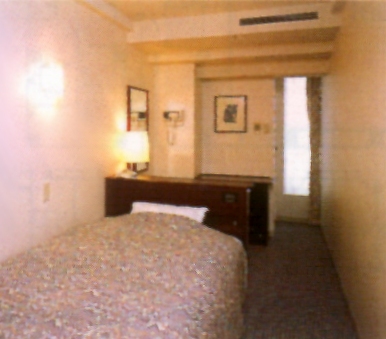 |
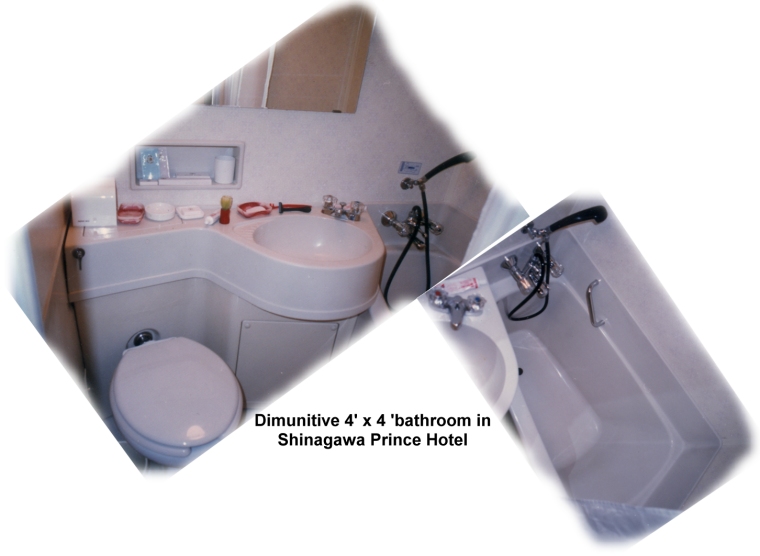
A four-foot by four-foot bathroom has an acrylic bathtub, washbasin and toilet all molded together as one piece.
The National TV is all white. The enameled metal wardrobe has a microprocessor based combination lock with an LCD display and tactile feedback keys. A beautiful, neatly pressed, striped blue kimono (traditional Japanese clothing) is the first sign of hospitality. The kimono is not made to fit, but comes in a standard size. The wearer is to adjust the kimono to their own individual size by the way they put them on.
Shinagawa is one of the major city centers located on the Japan Railways Yamanote Line. Shinagawa developed as an urban center because it is a nexus for the main transportation routes coming in from the south.
Historically, Shinagawa was a stop on the Tokaido, the Eastern Ocean Road followed by the processions of feudal lords in the Edo period, when it is said, it was a lively entertainment district. Later, in the Meiji period, it became an industrial area and featured the first Tokyo train station, the end of the line that connected Tokyo and Yokohama. I visited the Takanawa Shinto shrine which was near the Shinagawa Prince Hotel.
Shinkansen.
Shin-kan sen in Japanese means, "New-Trunkline".

The Shin-kan-sen trains aren't just faster trains. They have completely separate tracks from all other trains, the tracks are protected by fences, and there are no level crossings (road intersections) whatsoever.
Shinkansen is unbelievably fast, punctual and silent - The rails are all individually welded together into one smooth line that runs for hundreds of miles. This removes the "click-clack" of trains typical of almost everywhere else in the world. The trains are ultra-clean and the leg-room (even for tall people) feels like 1st class air travel.
The tracks have earthquake detectors that automatically shut down the trains, which are all electric. Since they stop at very few stations, much of the bullet train lines run through rural areas away from the regular train lines. While they stop at many main city railway stations, in several cities the Shinkan-sen has a separate station all its own, like Shin-Kobe and Shin-Osaka stations (shin means 'new'). You may have to take another train or a bus to reach the main downtown station.
The Shin-kan-sen bullet-train is a very nice train, but it didn't seem too high-tech in 1996. The design is somewhat Art Deco with lots of brushed aircraft aluminum and stereo ads featuring American popstars. It's very clean, but like typical train air-conditioning, my usual experience with the Mumbai-Pune Indrayani express, Chennai a/c two-tier, etc., it gets too cold inside. The people inside this purported technical marvel demonstrate the absolute indifference of long habit.
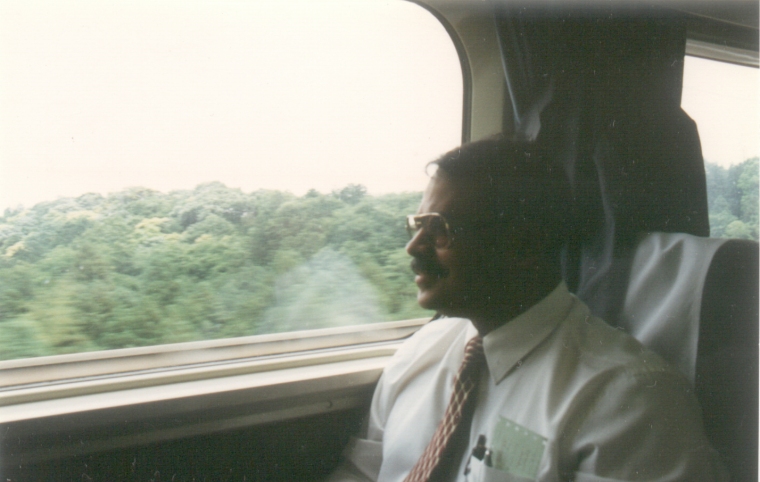
At first, the speed did not seem a whole lot faster than the ICE (Inter-City Express) I rode from Stuttgart to Frankfurt.
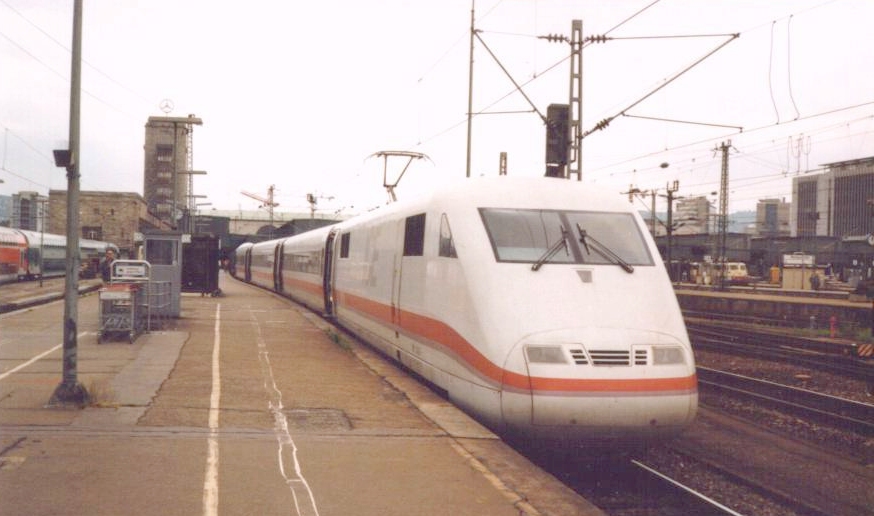
ICE-1 at Stuttgart Hofbahnhof, Germany
It is not until you look out the window that you realize just how fast you are going- there's no noise, and no discomforting acceleration. However, the cambered corners and pressure-induced sway as two trains pass each other, reminds you sufficiently that this is no ordinary train journey!
Shinkansen always arrive at the second in the timetable. The doors always open at the exact location indicated on the platform. The train moves off typically some 30 or so seconds later.
There are reserved and non-reserved carriages, and non-smoking cars are provided. Reservations are easily obtained from the ticket office. Your ticket indicates your assigned carriage number and it is important to determine where your carriage will stop on the platform so that you can board the train before the doors close and the train pulls away in 30 seconds. Similarly, be prepared to alight as soon as the train stops! Waitresses pushing laden trolleys regularly patrol the cars offering food and beverages. The Japanese often grab a bento box (boxed lunch) at the platform (These are inexpensive and typically less than ¥900) before joining the train.
My train, the Tokaido Shinkansen-Hikari on Monday, 3-June '96 departed Shin-Yokohama at 10:37 and covered the 489.9 km distance to Shin-Osaka in just under two hours and forty minutes, stopping at Nagoya and Kyoto on the way.
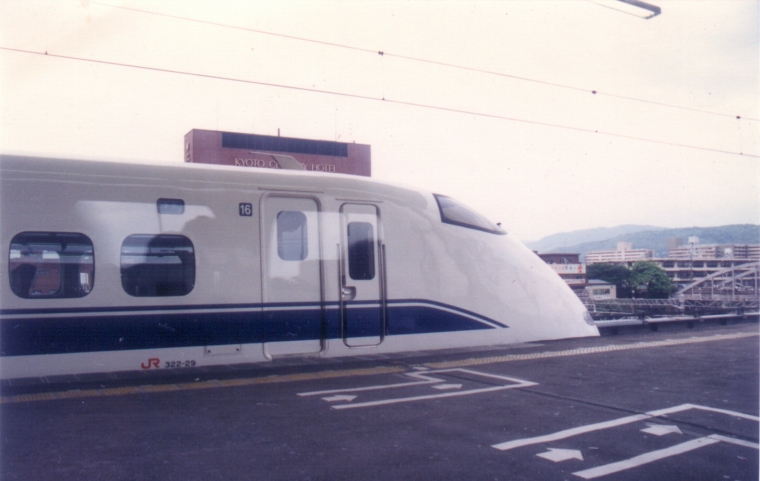
Kyoto was Japan's capital for over 10 centuries, from 794 to 1868, and it is still the country's cultural center. Within this busy, modern city-famous for its bridges, waterways, flowering trees, palaces, and religious festivals-are some of Japan's oldest and largest wooden structures.
There are three varieties of Shinkansen bullet-train service, Kodama, Hikari and Nozomi.
Kodama (for speed of an echo) travels at 270 km/h, has unreserved cars and stops in every station.
The oldest variety of train called the "000 series", could still be seen in 1996 used on the Kodama service. These entered service in 1964 on the Tokaido Shinkansen between Tokyo and Shin-Osaka.
The nose profile was based on that of the Douglas DC-7C airliner, which represented the state of the art of international air travel at the time.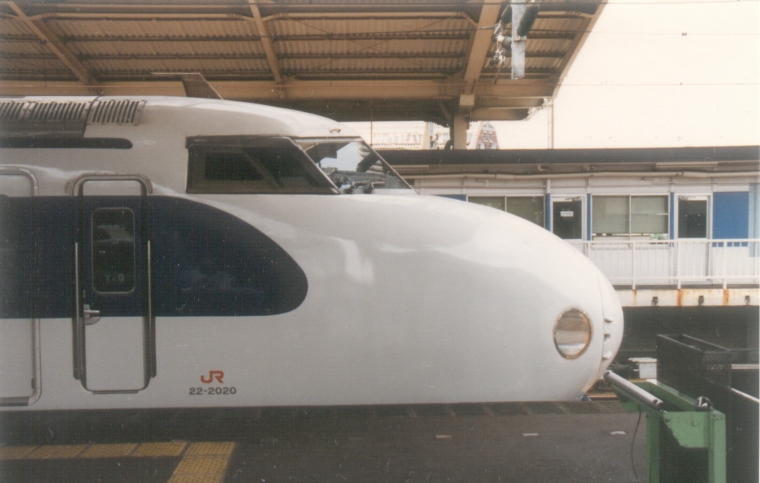 |
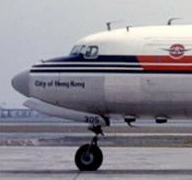 |
Initially formed as 12-car units, all cars were powered, relying on a new 25,000V AC (60Hz) overhead supply, giving a top speed of 210 km/h. The maximum speed was raised to 220 km/h in 1986 following improvements to the infrastructure on the Tokaido/Sanyo Shinkansen lines.
Hikari (speed of light) travels at 290 km/h
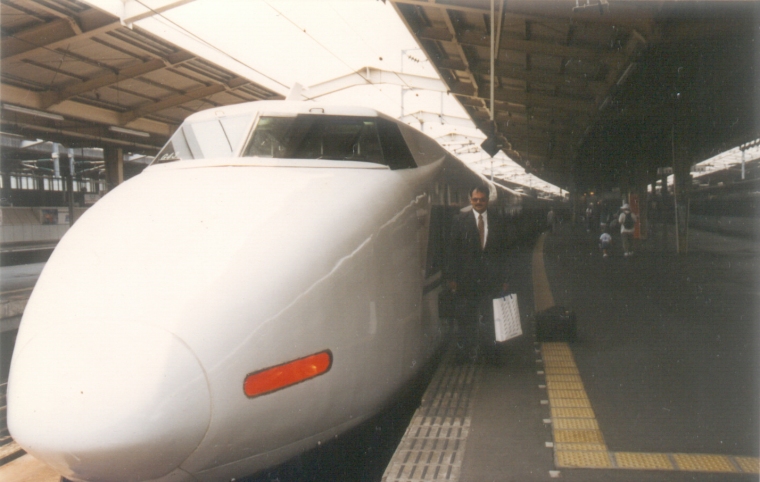
Tail-end of Series 100 type on Hikari service at Shin-Osaka
Nozomi (speed of hope, a wish or thought). The 16-car 300 series trains were used on the Nozomi services in 1996 between Tokyo and Shin-Osaka. Powered by AC 3-phase 300kW asynchronous motors, they ran at 270 km/h. Motored rakes have an AC regenerative braking system, while trailed rakes use eddy current braking as on the 100 series trains. The bodies are made of aluminium and have bolsterless bogies.
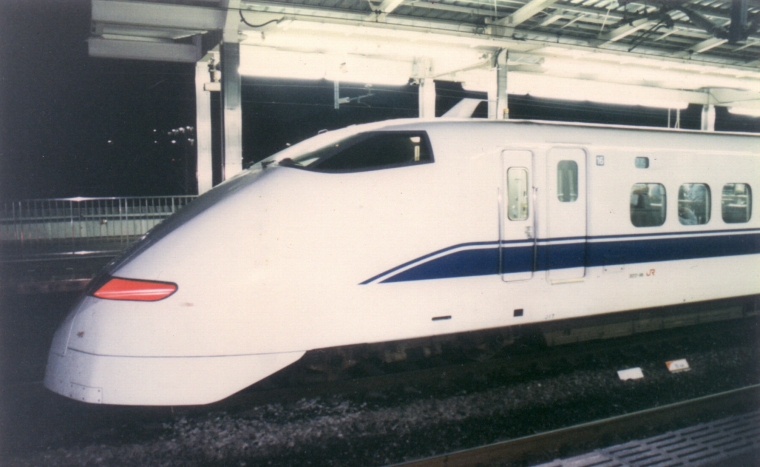
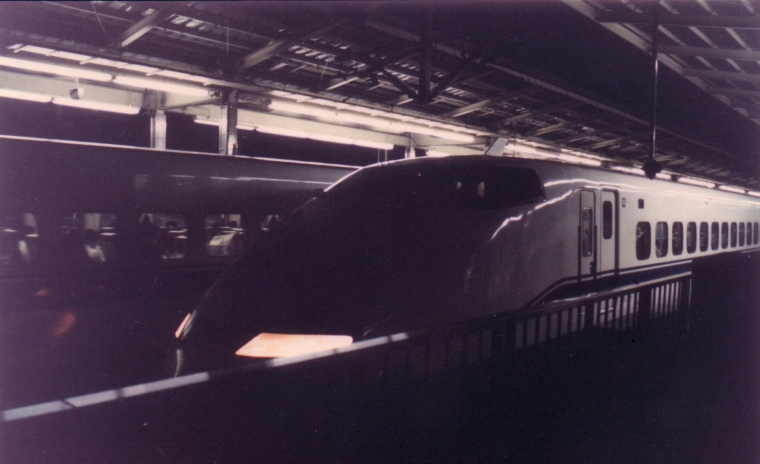
The 16-car 300 series trains were used on the Nozomi services in 1996 between Tokyo and Shin-Osaka. Powered by AC 3-phase 300kW asynchronous motors, they ran at 270km/h. Motored rakes have an AC regenerative braking system, while trailed rakes use eddy current braking as on the 100 series trains. The bodies are made of aluminium and have bolsterless bogies.
Culture
When Japanese people meet they bow. Then they often engage in ritualistic exchange of meishi, or business cards.
Before they walk into somebody's home, they take off their shoes and put on slippers provided for the purpose.
Respect for social hierarchy permeates nearly every aspect of Japanese culture. The Japanese are constantly concerned with deference and avoiding offense or any kind of direct confrontation. Most Japanese will avoid direct eye contact with you on the street, or in conversation. They consider direct eye-contact or "eye-balling" someone, extremely invasive and offensive behavior.
Along with this is the Japanese disdain for directness. Japanese never argue - they discuss! They don't open all their cards on the table - they feel it out! Do not expect that a Japanese person agrees with you when he says (Hai!) yes. Quite possibly, he is simply indicating that he is still listening. The Japanese will not normally disagree with you outright. Never answer the Japanese with "No". Instead, "Yes, I hear you, but it differs"
There are many etiquette issues encouched in the Japanese language. My customer complained to me good-naturedly about the behavior of one of my salespeople. When he asked the salesperson, why the document was late, my man began his sentence with, "Because...". This infuriated my customer. You never say, "Because...". Always by saying, "There is no excuse..." (Shitsureishimasu!)
The Japanese are by nature, polite. You must thank people, even when you are buying things from them. Also, the Japanese normally consider the passing of money to be rather offensive. So, when you are buying something, look for a tray of some kind. That's where you are expected to put your money, and that's where they'll put your change. Would you believe it, this was even expected of me while converting Thomas Cook travelers cheques to Japanese Yen in a bank's foreign exchange department office.
Akihabara
Akihabara is called Electric Town, and is the ultimate window shopping place for Japanese electronic technology. There are many electronics shops, with audio and video equipment such as TVs, radios, cassette tape and CD players, household appliances and portable and desktop computers. This area is famous for its discounted prices and duty-free shopping for tourists.
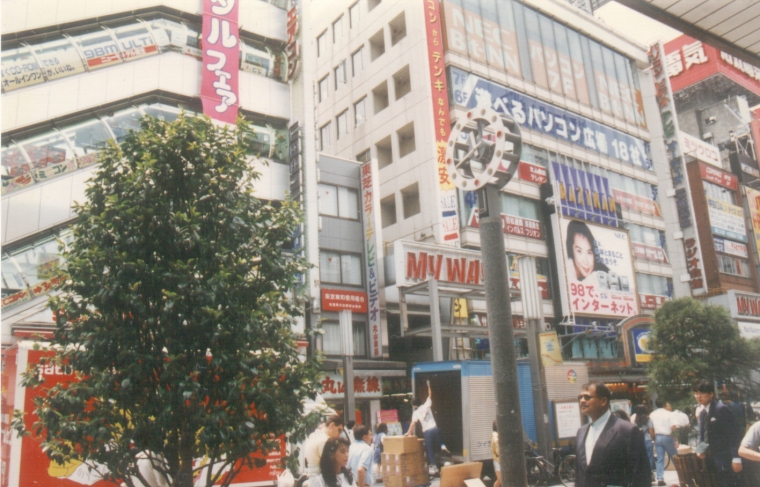
My host, Mr. Nozomi Tanabe and I took the JR train (Yamanote line) to Akihabara, exited the station through the "Electric Town" exit.
Across the street was a short block of stores, six stories high, selling everything from refrigerators to earphones for Walkman players. The signs were bright and colorful, and even more so when illuminated at night. We window-shopped along Chuo-dori Avenue. It was a holiday and the normally heavy vehicular traffic was conspicuous by its absence. On Sundays and holidays, cars are not allowed to ply on Chuo-dori Ave.
Among unusual products I saw were a Panasonic tabletop fan with light breeze mode where the speed of the fan is electronically varied to simulate a lazy varying breeze.
We also visited the Transportation Museum at Akihabara. Here was an exhibit documentary of the progress of railways and other means of transportation in Japan.
In my very first evening in Tokyo, the day I arrived, Abhijeet Barde and I visited the Tokyo tower. This is a 333 m tall steel structure roughly similar in shape to the Eiffel Tower, Paris, but taller and made of less steel. The nearest station is Kamchiiyacho station on the Hibiya line.
Technology
Ever since I acquired my $1200 Nikon FE2 SLR camera in January 1985, Japanese technology has awed me. In this trip, I had occasion to use a brand-new autofocus Nikon SLR camera. The smoothness of its stepper motors, performing multiple functions continue my respect for Japanese meticulousness. I purchased a point-and-shoot camera, an Olympus mju. When you snap open the lens cover, the built in 38..105 zoom extends out, as does a pop-up flash, with a robot-whine as in Robocop 2.
Wherever I went in Japan there were photocopiers of all sizes and flavors as were LCD displays of all sizes.
The conference rooms at Matsushita had Panaboards. The Panaboard is a $900 printboard or electronic whiteboard from Panasonic. After writing or drawing or even taping a picture on its surface, the user presses a button, and a built-in scanner captures the image and sends it to an attached black-and-white thermal printer. Inside the printer is a roll of A4 size thermal paper (similar to faxpaper) on which the image is printed. Multiple copies are possible while the scanning head travels, left to right and back.
On the streets and highways, familiar-looking Japanese cars sport unfamiliar English names that would not pass muster in a US showroom. There's the Toyota Crown Royal Saloon, the Mazda Bongo, the Nissan Cedric and Silvia.

Toyota Crown Royal Saloon G
Other unfamiliar cars in Japan include: "Nissan Big Thumb", "Nissan Leopard J Ferie", "Nissan Fairlady Z", "Mazda Bongo Brawny", "Mazda Proceed Marvie Wild Breeze", "Mazda Familia Interplay", "Mazda Autozam Carol Melady", "Toyota Hiace One Day Trip", "Toyota Land Cruiser 80 Active Vacation", "Toyota Estima Lucida G Luxury Joyful Canopy", "Mitsubishi Pajero Field Guard", "Mitsubishi Delica Green Field", "Mitsubishi Mirage Cyborg R", "Mitsubishi Debonair Exceed", "Mitsubishi MUM 500 Shall we join us?" -- (Yes, the question is part of the name.), "Daihatsu Rugger", "Daihatsu D-Bag 4", "Suzuki Escudo Esprit Fun-About 4x4", "Suzuki Jimny Wild Wind" and "Suzuki Every Joy Pop Sound"!
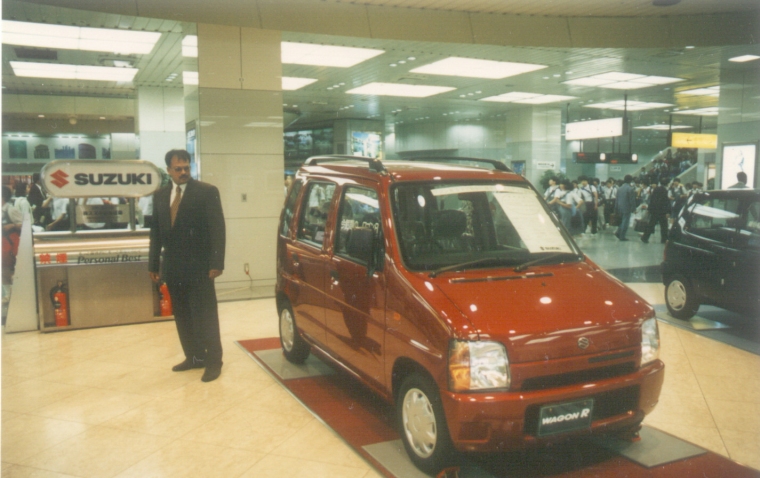
The 1996 Suzuki Wagon-R displayed at Tokyo's Narita International
Airport.
It would be the latest model in India in 2001, five years later.
Pachinko
The word pachinko derives from pachi-pachi, which describes the crackling of a fire or the sound of small, hard objects clicking together.
The game pachinko has changed little since the first commercial parlors opened for business in Nagoya, midway between Tokyo and Osaka, not long after World War II. Pachinko's bright boards give it flash, but little steel balls are its core: they fall vertically through the upright machine, in mesmerizing patterns, bouncing off nails and eventually dropping into one of many winning holes or being swallowed back by the machine.
In the deafening Pachinko game parlors scattered across Tokyo, scores of businessmen wearing black suits, gamble away tens of thousands (maans) of Yen and just as many hours firing tiny steel balls across a spike-studded, pinball-style game screen in the hopes of hitting a jackpot hole.
You receive bonus balls if you can land a ball in one of the three bonus areas. The two side bonus areas pay out a bonus of seven balls, while the center bonus area pays out seven balls plus a spin. If the bonus spin reveals three identical symbols, an additional bonus of 50 balls is awarded.
Clicking and holding on the launch button controls the launch velocity. The longer you wait to release the ball, the faster it will come out. An indicator beside the launch button shows the speed of the launch. You may purchase balls in 500 or 100 ball increments and can choose $.05, $.25, $1, or $5 balls. When you decide to cash out, you will receive money equal to the remaining balls multiplied by the dollar value of each ball.
Some gamblers read books, looking up only when a bell sounds a payoff, while others sit with the same riveted absorption common to videogame addicts.
The Pachinko parlor's neon glare has its place in Japanese social culture. The Pachinko industry draws over 3 crore adults to 18,000 parlors. It raked up 30.4 trillion yen (US$286 billion) in 1994! Pachinko khiladis come on their lunch breaks and after work picking their "lucky" seat along the rows of upright pachinko machines, pouring in zillions of steel marbles into winner bins. After a few good games, bins of accumulated balls are swapped back for an electronically labeled card that is used as currency at a booth hawking cigarettes, soap, pulp magazines, CDs, software or a special "gift" (a wornout tiepin or a rusty lighter) which can be swapped at a shady noodle vendor for hard cash!
Pachinko was once the adda of idle businessmen and wizened retirees and a few "pros". But chic modern halls like Maruhan Pachinko Tower, Nagoya cater to young working women, post-graduate students, families, and "salarymen" catching a quick game between clients. Players typically trade 1,000 yen to 10,000 yen (around US$10 to $100) for a card, which buys a flood of shiny silver balls from a stand-up machine.
Atop an ocean of buildings, huge neon signs rising several stories high scream out their messages of commerce in English and Japanese.
In Japan, as in big-city Indian schools, but unlike in the USA, school children wear individuality-stifling, 2nd wave industrial-era apparel: School-uniforms.
I arrived back in Bombay on Saturday, 8th June 1996 by Air-India AI-309 which departed Tokyo/Narita at 11:40 am that same day.